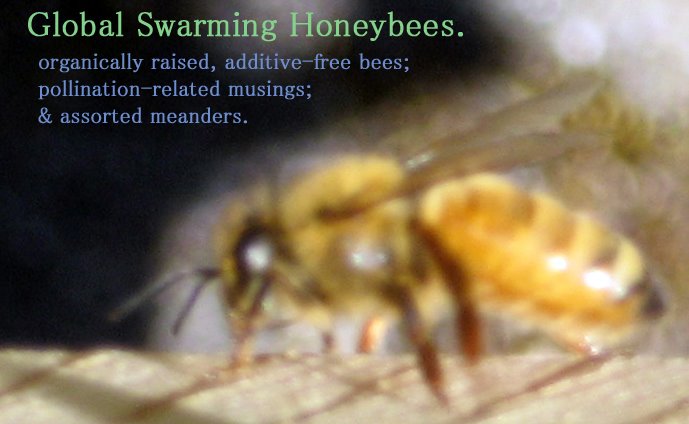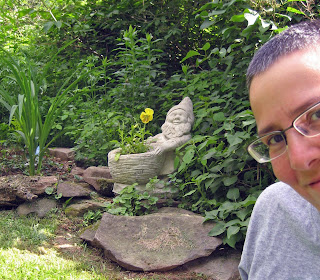Check out this wonderful article about the Rosslyn Chapel's beehive. Carved of stone 600 years ago, with a beautiful flower-shaped passage for the bees, this hive nestled within the ancient chapel's complex architecture appears to have been designed solely as a haven for the bees, rather than a beekeeping or honey-getting ploy. Now that's what I call sacred!
Carved of stone 600 years ago, with a beautiful flower-shaped passage for the bees, this hive nestled within the ancient chapel's complex architecture appears to have been designed solely as a haven for the bees, rather than a beekeeping or honey-getting ploy. Now that's what I call sacred!
3.31.2010
R-E-S-P-E-C-T, Circa 1400
And Now A Word About Healthcare Reform
Straying off topic for a moment to share this bit of sanity with ya'll.
3.30.2010
Take The U.S. Bee Loss Survey
The Apiary Inspectors of America, USDA, and Penn State are running their annual online survey to assess honeybee colony losses for 2009-2010. Take the survey here.
Unfortunately, the survey (which is clearly aimed at commercial beekeepers but inclusive of all) doesn't include many questions that, to my mind, might help illuminate what's going so very wrong with beekeeping these days. Not a word about colony management in terms of chemical treatments, feeding practices, winter prep/insulation, other environmental factors, etc. Interesting that these important areas are omitted.
Nevertheless, the survey results may at least provide a snapshot of the patterns of losses throughout the U.S. (and, for the first time, the Caribbean). So it's worth the 5 minutes required to participate, and at the end you can sign up to receive the report on the survey findings to be released this summer.
3.29.2010
Thought for the Day
Last week was a good and productive time in the bee yard. I made a lot of headway preparing for the two new packages of bees due to arrive sometime in the next several weeks.
The really great news is both of our existing hives are apparently well. Amazingly, Hive Orange, one of the two original hives we started off with in April 2007, has survived yet again and is going strong, with plenty of honey and, it appears from my views through the observation window, plenty of bees. This is with very little intervention and no chemical treatments, ever.
I can't take credit for any of this as the beekeeper, especially since last year, due to some difficult personal circumstances, I did almost no colony "management" in the spring, summer, or fall. Aside from reducing the hive entrances in winter and adding a layer of insulation to the top of each hive and the area behind the false backs, I did little to support or interfere with the bees' natural processes. This has been my general approach overall, but it certainly reached new peaks (or lows) of nonintervention last year. And yet the bees survived. Perhaps there's a message in that.
3.20.2010
Where Would We Bee Without Willows?
I spent a marvelous afternoon in the Brooklyn Botanic Gardens on Wednesday, bee-watching. Finally getting a few minutes to post images from the happy outing.I saw many honeybees working the crocus, lenten-rose, winter honeysuckle, and Cornelian cherry blossoms—all good things to plant if you're a city gardener looking to provide the bees with forage in early spring, when their options are limited and their need for pollen and nectar sources is great.
3.19.2010
Bee-Watching @ The Liz Christy Community Garden
The Liz Christy Community Garden, at the corner of the Bowery and Houston, is a fabulous little gem with the distinction of being NYC's first community garden.
Not much is in bloom there yet, but the lone honeybee gathering pollen from the miniature tulips generously allowed me to grab some nice shots of her beautiful self with my iPhone. With assistance from the afternoon sun, she cast lovely shadows on the tulip's petals. (As always, click the pic for a bigger, better view.)
3.17.2010
Press Coverage Round-up on the Legalization of Beekeeping in NYC
Ahhh...I feel lighter today as if...a ban...has been lifted...from my shoulders....It's great to wake up in the city where keeping bees is no longer a crime.
One of my hive-mates at the NYC Beekeepers Association was kind enough to round up some of the extensive press coverage on the overturning of the beekeeping ban in NYC yesterday.
Before presenting the media coverage, though, I'd like take a moment for the "First Things First" department. Let's recognize and honor the hard work of the people at Just Food, which led this charge so ably and so well. Here's a summary of their efforts. We all owe them a debt of thanks.
Here are some of the many media stories about the "banning of the ban," for the newshounds among you.
NBC News, "Big Apple Lifts Beekeeper Ban"
The Globe and Mail, "The Big Apple, Where Honey Talks"
The New York Times, "NYC Abuzz: Sweet Deal Makes Bees Legal"
On Earth, "Sweet News: New York City Dumps Beekeeping Ban"
LA Times, "Sweet News for Colonies: NYC Legalized Honeybees in a Boon for Keepers of Rooftop Hives"
HuffPo, "New York City Officials Decide to Allow Beekeeping"
Have you seen other notable coverage on the lifting of the ban? Leave a comment and let me know!
3.16.2010
Beet the System
 Cool stuff over here at Black Sheep Heap, T-shirt-wise, logo-wise, and slogan-wise.
Cool stuff over here at Black Sheep Heap, T-shirt-wise, logo-wise, and slogan-wise.
Beekeeping is Legalized in NYC
It's official. As of this very sunny morn, the ban on beekeeping here in New York City has been lifted!
All hail the many individuals and organizations who worked so hard to make this happen.
3.15.2010
The week begins...
with the hope that, in the next few days, some good news will be coming down the pike for New York City beekeepers and wanna-beekeepers. See this article in today's New York Times.
If you're a New Yorker with an interest in beekeeping, now is a great time to become a part of the New York City Beekeepers Association. Join NYCBA's Facebook page to keep up with the latest. And sign up for our official mailing list by visiting the NYCBA website.
3.13.2010
Bugs, Up Close and Personal
In the mood for bug?
These insect "micrographs" by Steve Gschmeissner will, I promise, blow your mind. They were taken using a Scanning Electron Microscope, which (so I read) can magnify its subjects up to a million times—a concept I can't even really wrap my brain around (but then I'm not an SEM).
The full gallery appears on the Telegraph website. When you go to this page, after you take in the phenomenal blue flea, note the small photo gallery on the upper right side of the page and arrow through the entire gallery of 12 stunning shots. To whet your appetite, the image above is a colored SEM micrograph of the head of a bee (Photo by Steve Gschmeissner).
To whet your appetite, the image above is a colored SEM micrograph of the head of a bee (Photo by Steve Gschmeissner).
3.11.2010
The Idiots at Fox News
Stupid wingnuts vs. bugs, libraries, science, preservation, and brains. Read all about it here.
3.10.2010
Sex. Plants. Pollen.
I guess, what with the weather and all, pollination is on everyone's mind.
Take a look at Olivia Judson's latest in yesterday's New York Times. It's called Breezy Love, Or The Sacking of the Bees.
Oh and thanks, Eva, for bringing this to my attention.
3.09.2010
Go Forth and Pollinate
We're getting a delightfully unexpected spate of warm weather and around here; the crocuses are going nuts and even some dandelions are blossom-poppin'.
This, of course, turns the mind toward bees. Wren and I were pleased to see a couple of honeybees hovering around the witch hazel blossoms at the Brooklyn Botanic Garden on Saturday, but may have arrived a bit late in the day to catch the action on the crocuses.
I remember our first spring of beekeeping, the thrill of realizing that our hives had successfully overwintered. We arrived upstate early one Saturday afternoon in April and found the bees gathering pollen from our purple crocuses. The photo below was taken on that day.As we all continue our blissful (if temporary) Vulcan mind-meld with Springtime, I've collected links to a few good sites on the pollen plants bees depend on.
For those of you who garden, I hope these lists will inspire bee-friendly choices. The more good stuff (nectar, pollen) is out there for the bees—especially in early spring and during "dearth" periods like late summer—the better off they'll be. For the rest of us, beekeeper and bee-worshiper alike, I hope knowing a little more about the pollination aspect of things will be enriching.
New Jersey Beekeepers Association list of pollen-nectar plants.
Nectar and pollen plants of the Pacific Northwest.
A list of good things to plant for bees if you're located down South.
An "intro to pollen" from Wikipedia.
A list of crop plants pollinated by honeybees.
A super-cool pollen color chart (also from Wikipedia).
Below, one of our honeybees packing her pollen basket with the asparagus blossoms' bounty.
3.07.2010
Underrated Ants
Keeping bees has greatly increased my appreciation for ants—not that I was ever bored by them. Like bees, ants are social insects that exhibit impressively complex behaviors and lead wildly diverse lives.Last summer I bought a cool ant-identification guide that, while difficult for a total amateur like myself to use, blew me away with the sheer variety of ants to be found in our North American backyards. This doesn't even begin to touch upon what's out there in other parts of the world—or the literally thousands of "undiscovered" species. How wonderful and appealing to be an undiscovered species in 2010; I like the sound of that!
This rather amazing video from The Smithsonian provides a "guided tour" of some of the more exotic and interesting ants out there. Enjoy!
3.05.2010
The (Truly) Great Plains
Feeling a little cooped up this winter? Take a few moments to breathe in some serious beauty....
3.03.2010
robot bee
 Killing time with 2 Googlin' word-combos that just crossed my mind:
Killing time with 2 Googlin' word-combos that just crossed my mind:
Robot bee.
Robotic insect.
3.01.2010
Snowbound Hives
 Isn't this a wonderful photograph? It was sent yesterday by Bettina Utz, one of my fellow core members in the NYC Beekeepers Association.
Isn't this a wonderful photograph? It was sent yesterday by Bettina Utz, one of my fellow core members in the NYC Beekeepers Association.
Aside from the incredibly pleasing aesthetics at play, what's kind of great about the way the snow is capping these hives is that it mirrors the natural, bell-like shape of honeycomb itself, as seen in this picture from one of my top-bar hives taken a couple of summers ago.
One hopes and imagines that the colonies in Bettina's hives are benefiting from the insulation of their gorgeous "hats" of snow, and that spring will soon release them (and all of us!) from this long winter's nap.





